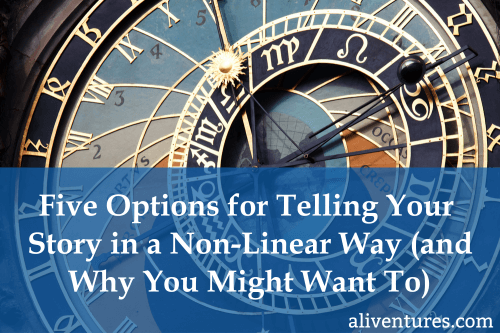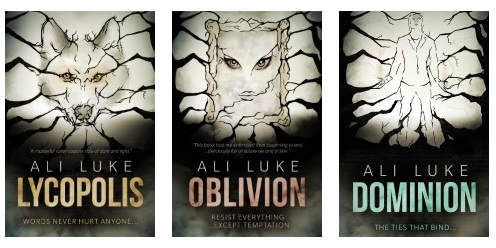Five Options for Telling Your Story in a Non-Linear Way … and Why You Might Want To

Stories have a beginning, middle, and end … but they don’t necessarily need to be told in that order.
Plenty of stories follow the advice given to Alice by the King in Alice in Wonderland: “Begin at the beginning […] and go on till you come to the end: then stop.”
But many others aren’t told in a fully linear fashion. Perhaps they begin at the end, then jump all the way back to the beginning. Or maybe they begin in the middle, and fill in the backstory while also moving the narrative forward.
Here’s a (non-exhaustive!) list of ways to craft a non-linear story. You might use just one of these – or several.
#1: Using Flashbacks
Plenty of stories use flashbacks – even if the rest of the story is told chronologically. Flashbacks are a quick and convenient way to fill in a character’s backstory in a dramatic way. Often, they begin as a memory:
As I lay there in the stifling quiet of the room, my thoughts began to circle back to that horrible day in June. […] As soon as I turned the key in the lock, I could tell someone was in the house. The air felt charged, like someone was holding their breath.
He was standing in the living room, a dark shape silhouetted against the bay window.
‘Eddie! What are you doing home?’
‘I can’t do this, Juliet.’
‘Can’t do what?’
He looked at the floor, and ran a hand through his floppy hair. ‘I can’t go through this with you. Your mum and all that shit… and the IVF. It isn’t right to have a kid with you. Not when things aren’t right between us.’
(From The Child in My House, Lucy Lawrie)
Flashbacks are a great way to help reveal characters’ backstories (and give us a sense of what motivates their current actions). They can help to create a more complex plot, especially if misunderstood or half-remembered events in the flashbacks impinge on the present.
Flashbacks can also be a good way to create tension or suspense in your story. Perhaps a flashback reveals something that relates to something important in the present-day narrative that the reader knows about – but the remembering character doesn’t.
#2: Using Flashfowards
A flashforward is a scene (it can be a very short one) that reveals something that is going to happen in the future of the story.
This is a less common device than flashbacks. A short flashforward can be used to create tension or a sense of irony or pathos.
Here’s an example of a simple and brief flashforward in Ian McEwan’s Atonement. 13-year-old Briony Tallis has just finished watching her mother read the play she’s written:
[Emily] took her daughter in her arms, onto her lap – ah, that hot smooth little body she remembered from its infancy, and still not gone from her, not quite yet – and said that the play was ‘stupendous’, and agreed instantly, murmuring into the tight whorl of the girl’s ear, that this word could be quoted on the poster which was to be on an easel in the entrance hall by the ticket booth.
Briony was hardly to know it then, but this was the project’s highest point of fulfillment. Nothing came near it for satisfaction, all else was dreams and frustration.
(From Atonement, Ian McEwan)
We know from this that Briony’s hopes for her play, which she plans to stage with her visiting cousins playing various parts, are sure to be dashed. Flashforwards let the reader in on something that the character doesn’t yet know, letting us read what comes next in the light of that.
#3: Framing the Narrative By Starting at the End
Some stories begin near to the end, at the start of the story’s climax, before backtracking a good distance to tell us what’s happened to lead up to that point.
It began with my father not wanting to see the Last Rabbit, and ended with me being eaten by a carnivorous plant. It wasn’t really what I’d planned for myself. I’d hoped to marry into the Oxbloods and join their dynastic string empire. But that was four days ago, before I’d met Jane, retrieved the Caravaggio or explored High Saffron. So instead of enjoying aspirations of Chromatic advancement, I was wholly immersed within the digestive soup of a yateveo tree. It was all frightfully inconvenient.
(From Shades of Grey, Jasper Fforde)
Having a framing narrative inevitably removes some degree of suspense: we know that the characters in the very first scene are going to survive for at least most of the story! But it can also be a great way to start with a clear “hook” and draw the reader into the story fast.
#4: Telling the ‘Past’ and ‘Present’ Story in Parallel
A more involved option, if you want to create a non-linear narrative, is to tell both the past and the present of the story in parallel. As you advance the “past” story, revealing more information and furthering the plot, you’re also advancing the “present” story.
Behind Closed Doors uses this structure, heading each chapter with “Present” or “Past” – with the chapters alternating between the two. The first chapter introduces Jack and Grace in the present, and it’s clear that something dark is lurking beneath the surface:
The champagne bottle knocks against the marble kitchen counter, making me jump. I glance at Jack, hoping he won’t have noticed how nervous I am. He catches me looking and smiles.
…
There is a complicated alarm system, with steel shutters to protect the windows on the ground floor. It must seem strange that these are often kept shut during the day, but as Jack tells anyone who asks, with a job like his, good security is one of his priorities.
…
I feel a momentary wave of panic that I might not be able to pull everything off, but reminding myself that fear is my enemy I try to remain calm and return to the sitting room with the tray of canapés.
(From Behind Closed Doors, B.A. Paris)
As we switch to the past, all seems well to begin with as we see Grace and Jack’s whirlwind marriage, but then Jack’s abusive nature becomes abruptly clear once they’re married and on honeymoon. More and more details are filled in by the past narrative as the present story also moves forward, with Grace desperately plotting to protect her younger sister, Millie, from Jack.
#5: Using Multiple Timelines (Different Generations or Eras)
Some writers split their stories across time, dealing with storylines that might be generations or even eras apart. Obviously, for this to work, there needs to be some sense of connection between the different parts of the narrative. That could be a family link, a mystery from the past that persists in the present (such as an unsolved crime), or a more thematic connection.
Cloud Atlas is a fairly extreme example of this, with 6 different nested stories, each one read or observed by the main character in the next story. Each character’s story is told in a very different style The contents page looks like this:
The Pacific Journal of Adam Ewing
Letters from Zedelghem
Half-Lives
The Ghastly Ordeal of Timothy Cavendish
An Orison of Sonmi ~ 451
Sloosha’s Crossin’ an’ Ev’rythin’ After
An Orison of Sonmi ~ 451
The Ghastly Ordeal of Timothy Cavendish
Half-Lives
Letters from Zedelghem
The Pacific Journal of Adam Ewing
(From Cloud Atlas, David Mitchell)
The difficulty with using multiple different timelines is that the reader may get lost in the jump between one and the other. If you’re switching back and forth between timelines, one aspect of the story might be more interesting and engaging to the reader – leaving them bored with the other part(s).
These aren’t the only possible non-linear structures, of course. You could write a story that jumps around in time, with very little of the narrative progressing in a chronological fashion. Or you could tell a story using letters, diary entries, or newspaper clippings, not necessarily presented in chronological order.
There’s absolutely nothing wrong with writing a story that progresses in strictly chronological order, using time jumps where needed. However, non-linear storytelling can open up possibilities for crafting a story that engages the reader in a different way, or that deftly handles complex characterisation and plotting.
Even if your story follows a fairly conventional structure, you might still want to use some non-linear elements, such as flashbacks or flashforwards. Feel free to experiment and see what works for the type of story you want to tell.
About

I’m Ali Luke, and I live in Leeds in the UK with my husband and two children.
Aliventures is where I help you master the art, craft and business of writing.
Start Here
If you're new, welcome! These posts are good ones to start with:
Can You Call Yourself a “Writer” if You’re Not Currently Writing?
The Three Stages of Editing (and Nine Handy Do-it-Yourself Tips)
My Novels

My contemporary fantasy trilogy is available from Amazon. The books follow on from one another, so read Lycopolis first.
You can buy them all from Amazon, or read them FREE in Kindle Unlimited.

0 Comments